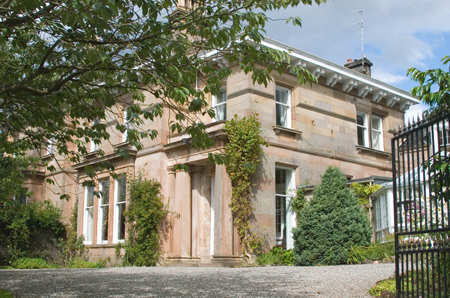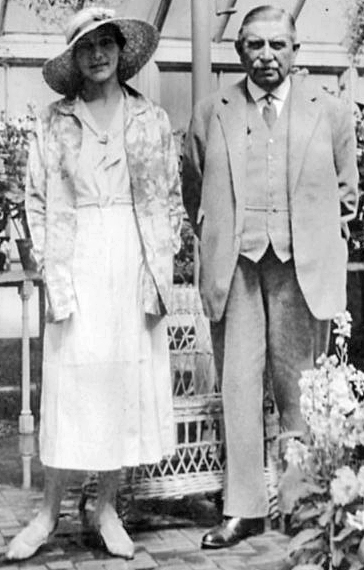THE FIRST holder of the Baronetcy of Helensburgh was Sir William Raeburn.
The Raeburn Baronetcy of Helensburgh in the County of Dunbarton is a title in the Baronetage of the United Kingdom, and it was created on July 25 1923 for the Conservative MP for Dunbartonshire, head of the shipping company of Raeburn & Verel Ltd.
He then became Sir William Hannay Raeburn, 1st Baronet of Helensburgh, selecting this title because he lived here — and many of his descendants still do.
Sir William, a Justice of the Peace, lived in Woodend (pictured below), a splendid mansion in Millig Street, which was for a time a St Bride’s School boarding house and today is flatted and has particularly attractive modern homes in its extensive grounds.
The late Mrs Winifred McKenzie, who lived in Rock Ibris and was very well known in the town, was a relative of Sir William, and several town and Rhu families are related to her.
Sir William was originally from Glasgow, where he was born on August 11 1850, and moved with his family to the burgh towards the end of the 19th century.
His Millig Street home was built in 1872 for a Mr Robertson, but Sir William engaged two of the best known architects to work in Helensburgh to make extensive additions to the property.
In 1901 William Leiper designed the imposing conservatory, and nine years later A.N.Paterson designed an Elizabethan window and a stair-hall timber screen. He also added a billiard room.
In 1916 the then William Raeburn was appointed president of the Chamber of Shipping by the shipowners of the United Kingdom, and on his retirement from that position that he was awarded a knighthood for services to shipping.
After the First World War Sir William was elected as MP for Dunbartonshire on December 14 1918, and he held the seat until 1923. At this point he received the baronetcy.
As an MP, he would also be well known to Helensburgh resident Andrew Bonar Law, Unionist Prime Minister for 209 days in 1922-23 until his death. There was a General Election in December of that year, and Sir William did not contest the seat — which the Unionists lost.
A memorial plaque on the north wall of St Michael and All Angels Episcopal Church was placed there by Sir William and his wife, Ellinor Martha, in memory of  their youngest son, Alfred Anthony Douglas Raeburn. Sir William was a member of the Vestry of St Michael's and a key figure in the erection of the church tower and provision of new bells in 1930.
their youngest son, Alfred Anthony Douglas Raeburn. Sir William was a member of the Vestry of St Michael's and a key figure in the erection of the church tower and provision of new bells in 1930.
A 2nd Lieutenant in the 9th Highland Light Infantry Glasgow Highlanders, Alfred was one of so many who lost their lives at the Battle of the Somme. His death on July 15 1916 was eight days before his 24th birthday.
In his business life Sir William was well known as one of the stoutest defenders of shipowners interests in the West of Scotland.
He played an important part in connection with most of the shipping legislation of the time, notably the Merchant Shipping Act and the Workmen's Compensation Act of 1906, and a year after that he was appointed a member of the advisory committee formed to confer with the Board of Trade about the working of the Merchant Shipping Acts.
He was a member of many Glasgow organisations of the time. These included being deputy chairman of the Clyde Navigation Trust, chairman of the Clyde Pilot Board, vice-chairman of Glasgow Local Marine Board, chairman of the Clyde District Committee of the Shipping Federation, a Clyde Lighthouses trustee, and director of the Sailors Home and the Royal Samaritan Hospital for Women.
He was also a director of the Empress Training Ship moored in the Gareloch off Kidston Park, on which lived 300 boys aged 12-14 who faced the risk of being drawn into crime because of family and other problems.
The Empress replaced the Cumberland, which was in use from 1869 until 1889 when it caught fire and burnt to the waterline, fortunately without loss of life. She remained there until the 1920s, offering tough and at times brutal training and harsh discipline — but also brass and pipe bands which were much in demand for social events.
After Sir William’s death on February 12 1934 aged 83, he was buried in Helensburgh Cemetery.
An obituary in the Helensburgh and Gareloch Times referred to him as Helensburgh's "most distinguished citizen and a generous giver", and added "To every deserving cause or institution from which an appeal was made Sir William gave with a great liberality and discrimination."
It refers to his gifts to St Michael's Church and then stated: "He was chairman of the Helensburgh Dwellings Company Limited, which erected workmen's houses in Maitland Street and have proved an asset to the town. The Horticultural Society found in him an honorary president who took a keen interest in the furtherance of its objects.
"He was president of the Amateur Operatic Society, and indeed it would be almost impossible to mention a local organisation which did not receive from him some measure of support if it required it."
 His first son, William Norman Raeburn, born in 1877, spent his early years at the family home and was a member of Helensburgh Cricket Club and a chorister at St Michael's Church.
His first son, William Norman Raeburn, born in 1877, spent his early years at the family home and was a member of Helensburgh Cricket Club and a chorister at St Michael's Church.
He was educated at Kelvinside Academy and Uppingham, then graduated M.A., LL.B from Glasgow University. He was called to the Bar by the Middle Temple in 1903, and took silk in 1909. He specialised in arbitration.
He became the 2nd Baronet in 1934, and died in 1947, when he was survived by his son Edward Alfred Raeburn, who became the 3rd Baronet, and two daughters.
When he died in 1977 his son Michael Edward Norman Raeburn became the 4th Baronet, but he does not use the title. His heir is his son Christopher Edward Alfred, who is in his late twenties.
The second son of Sir William was Sir Ernest Manifold Raeburn (1878-1922), who lived in West Abercromby Street and whose knighthood was also for services to the shipping industry. He died at the age of 43.
A notable member of the family was Sir Ernest's son, Major General Sir Digby Raeburn (1915-2001), who was in the Scots Guards and Governor of the Tower of London.
Sir Digby followed his successful career in the Army with an eight-year appointment as Governor of the Tower of London and Keeper of the Jewel House.
As Governor, Sir Digby was in command of the Yeoman Warders; as Keeper of the Jewel House he was in charge of the separate corps of Curators and Wardens and responsible for the security of the Crown Jewels.
With these appointments, which Sir Digby held from 1971 to 1979, went residency at the Tower in the Queen’s House, built by Henry VIII as a wedding present for Anne Boleyn. It was from the Raeburns’ spare bedroom that Anne went to her execution, after carving her name three times in the stonework of the fireplace.
He was in office in 1974 when a 10 lb terrorist bomb exploded in the Tower’s Mortar Room, a small basement exhibition hall. It was thronged with tourists, and one woman was killed and more than 40 injured. Sir Digby and his wife had just finished lunch when they heard the bomb go off.
- Woodend photo by Donald Fullarton.




